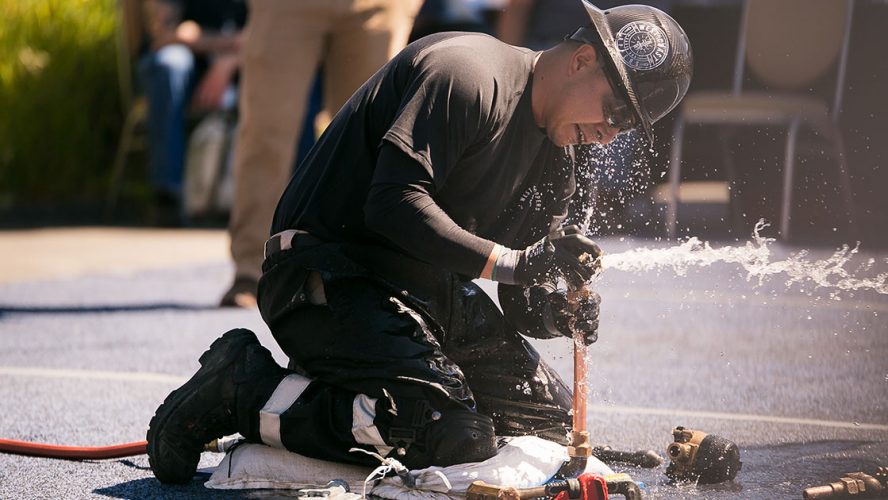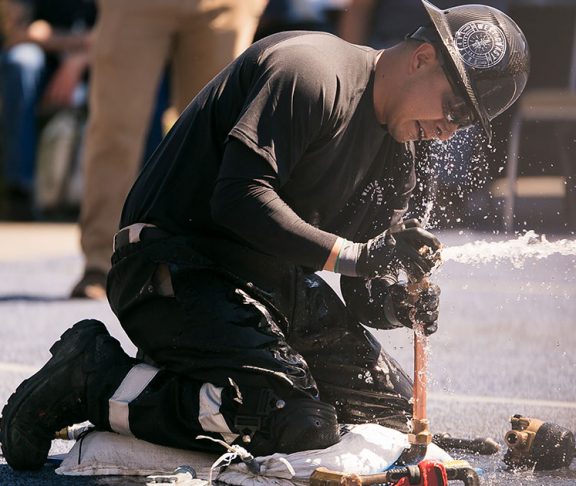One of the major improvements to public health in United States history derived directly from the proper treatment of drinking water and sanitation. Techniques and infrastructure developed and refined since the late nineteenth century have brought about a dramatic decline in mortality from waterborne pathogens that previously ravaged the population, causing diseases such as cholera and typhoid fever. The Centers for Disease Control called chlorination and treatment of drinking water one of the ten greatest public health achievements of the Twentieth Century.
The American Water Works Association (AWWA) was in the vanguard of this historic drive toward more universal access to safe drinking water. Founded in 1881, AWWA provides a crucial forum for the creation and diffusion of knowledge on methods and technical advances for the protection, treatment, and distribution of drinking water. Conferences and education programs deliver the latest developments, drawing on the most knowledgeable experts in the gamut of subjects of concern to water utility professionals throughout North America and overseas.
Educating water professionals
Early in the development of AWWA, leaders recognized that information and knowledge could most thoroughly be disseminated with regional organizations. There are 43 regional sections across the United States, Canada, and Mexico that hold conferences and educate through multiple means to reach a still wider audience of water professionals. The California-Nevada section, with approximately 6,000 members, draws on a wealth of scientific and technical know-how to provide input on drinking water regulations and legislation affecting utility members. Expert instructors deliver continuing education to keep water professionals at the forefront of developments in operations, treatment methods, laboratory analysis, source water quality, new technology, security, and more. Certification of “Advanced Water Treatment Operators” is a new program on schedule to be offered in the spring of 2019, with support from state regulators.
Promoting sound science and education for the public good is fundamental to AWWA, and the organization advocates for application of the best knowledge and latest research in public policy decisions. In 1966 the association helped launch the Water Research Foundation, which through a recent merger is the preeminent source of groundbreaking scientific and economic research supporting the water and wastewater community. AWWA and its members were a leading voice in shaping and the enactment of the Safe Drinking Water Act in 1974, as well as subsequent amendments and numerous regulations the flowed from it. Among the most significant achievements recently, AWWA and members again led the coalition that helped craft and secure enactment of the Water Infrastructure Financing Innovations Act, which adds an invaluable low-interest funding option for major water infrastructure projects.
With the amazing progress in water quality, engineering and public health protection of the past century, one might think the next one hundred years will be free of the challenges confronted by earlier generations. But unfortunately, that would be false. While the problems may not be exactly the same, the ultimate goal of universal access to sufficient, safe, affordable drinking water remains unchanged. What issues define the drive toward this goal for the current generation?
The challenges ahead
News headlines point to instances of failure of the modern system of water quality regulation. Failures prompt renewed efforts to address new or lingering problems. The failure of water utility management in Flint, Michigan shone an intense spotlight on the danger of corrosion that can leach lead into drinking water. Acting in a broad coalition, AWWA is actively promoting steps to safely remove all remaining lead exposure from drinking water systems. Other contamination sources are emerging that worry both public health and water utility professionals, yet the most appropriate actions are not clearly defined. Microbial pathogens such as the bacterium legionella (causing “Legionnaire’s disease”), or the amoeba Naegleria fowleri are identified as emerging risks, and these may be linked to warmer water sources as climate change continues.
Environmental contaminants caused by human actions present other challenges. There is a new term that captures a whole category: “contaminants of emerging concern.” Subgroups of these CECs include pharmaceutical and personal care products, fire retardants, and pesticides. One example that has risen to the top of the list for regulators and public health researchers is a group of organic chemicals called “perfluorinated compounds.” These manmade compounds have desirable characteristics for manufacturing a wide variety of products, by remaining stable under conditions of heat, and resistance to water, grease, or other effects. As a result, these chemicals are now being discovered, widespread in the environment in very low amounts. Being stable and resistant to breaking down, they are very persistent and can be transported in water. Health research is not yet definitive about human exposure, but animal studies point to possible endocrine hormone and reproductive impacts, and harm to organs from these substances.
Technological advancements
Technological advancements allow detection of chemicals in ever tinier amounts, measured in “parts per billion” and “parts per trillion” or nanograms and picograms. Science and policy struggle to keep up, as the effects of such tiny amounts of a substance are not well understood. One must ask, “How much is safe?” And the tradeoff comes in the form of the cost to society or individual budgets from actions to remove substances or prevent exposure.
While in theory the best policy would be to have all water perfectly pure and safe, in reality that is impossible and would be a poor choice. As it is, many small water systems — mostly rural but also in urban pockets — find it unaffordable to keep up with current water quality standards. Affordability has burst into full view as a major issue, and a plain fact is that many very small water systems are unsustainable, struggling with part-time or even volunteer operators. Increasing the margin of safety to address emerging contaminants exacerbates the affordability gap.
The need for AWWA, as a professional association dedicated to “total water solutions,” is just as great in the 21st Century as it was decades ago. Dedicated professionals are applying the best science, technology, economic and policy concepts, time and energy to finding answers to questions their forbears could have never imagined, all with the same core goal of providing effective solutions to ensure public health.
Timothy Worley, Executive Director California-Nevada Section, AWWA, [email protected]

